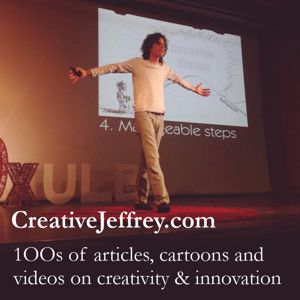Report 103
Your newsletter on applied creativity, imagination, ideas and innovation in business.
Tuesday, 3 March 2009
Issue 144
Hello and welcome to another issue of Report 103, your fortnightly newsletter on creativity, imagination, ideas and innovation in business.
As always, if you have news about creativity, imagination, ideas, or innovation please feel free to forward it to me for potential inclusion in Report103. Your comments and feedback are also always welcome.
Information on unsubscribing, archives, reprinting articles, etc can be found at the end of this newsletter.
PURPOSE DRIVEN INNOVATION
You have doubtless visited a hotel or restaurant or other service business where a small box invited you to offer suggestions on “how can we better serve you?” Very likely, you never bothered to make a suggestion because, like most people, you sincerely doubted anything would happen to your suggestion. Indeed, I often wondered if such boxes were ever emptied and suggestions read! In other words, you probably didn't make the effort to offer a suggestion because there seemed to be no purpose to doing so.
Likewise, many firms' suggestion schemes leave employees feeling the same way. They submit ideas by e-mail or by submission into a database and never hear another thing about their ideas again. It is rather like dropping a coin into a very deep well. It simply disappears without a sound, never to be seen again. As far as employees are concerned, taking the time to formulate and submit ideas serves no purpose, particularly if they are very busy. Most employees are. Indeed, in my experience, “lack of time” is one of the most frequently claimed excuses for not participating in an ideation initiative.
Whether ideas submitted to such suggestion schemes are implemented or not is immaterial to the idea submitters. They have received no information and can only assume that nothing has happened with their submissions.
Innovators Need a Purpose
On the other hand, seeing an idea, that you (either individually or as part of a team) have proposed, being implemented and turned into reality is a very powerful reward.
Implementation demonstrates that time and resources devoted to developing the idea have served a purpose. It demonstrates recognition of the employee's contribution and gives the employee a sense of having added value to the firm. When this happens regularly, employees are far less likely to complain that they do not have time to be innovative!
In short, innovators need a purpose. They need to believe that their suggestions have a realistic chance of being implemented. They need to feel that time spent developing an idea is time well spent. If they know good ideas will come to fruition, it is easier to bring teams together to develop those ideas. It is easier to sell ideas up the corporate ladder. Perhaps most importantly, regular implementation of ideas invites people to think creatively and that results in more innovation for your firm.
Transparency Is Critical
In fact, ideas submitted to suggestion boxes are occasionally implemented. The problem is that there is often little or no communication with the idea submitter. Hence as far as she knows – nothing has happened to her idea.
Thus it is critical that any idea generation initiative is transparent, not only during the idea generation phase, but also during the idea review and testing phases. Regular reports to the idea submitters lets them know how their ideas are developing and demonstrates the value that the firm gives to good ideas.
Good News and Bad News
Although good news about an idea's implementation is the best news an idea submitter can receive, no news is usually worse than bad news. If an idea is evaluated and found not to meet certain criteria considered essential for implementation, it is better that the idea submitter receives a report of this evaluation. Although not as nice as a passing evaluation report, it nevertheless demonstrates that the idea was considered valuable enough to warrant the time required for evaluation. That also communicates that the firm really is interested in ideas and is likely to implement ideas that meet or exceed certain criteria.
Moreover, if an idea is rejected at any time, a note explaining the rejection is better than no information. And if that note can explain the reason for rejection, it helps the idea submitter learn more about what kind of ideas are unlikely to be implemented and that can help her submit better ideas in the future.
At the very least, a rejection letter (or e-mail) tells the idea submitter that someone actually has read her idea. That, discussed at the beginning of this article, is more than many people believe happens when they submit an idea to a suggestion box.
Focus = More Implementations = More Purpose
One of the main flaws of suggestion boxes and open suggestion schemes is that they do not focus creative thinking. They do not give information about what kind of ideas the firm is looking for. Hence, all kinds of dissimilar ideas are typically collected, many of them irrelevant to business needs. This translates into a lot of rejected ideas. Indeed, very often it is simply impossible for the team managing the suggestion box to review the ideas efficiently. And the result is no feedback to idea submitters, even if the suggestion scheme managers wanted to provide it.
Hence, ideas campaigns and other ideation actions based on creative problem solving (where a manager starts with a problem and invites ideas that solve the problem) tend to have a higher percentage of implemented ideas. Moreover, because ideas are related to the problem, they can be evaluated more quickly and information can be sent to the idea submitters faster.
What You Can Learn from This
The main lesson to be learned here is that people will be more creative and share their ideas more frequently when they feel there is a purpose to doing so. Your innovation initiative need only meet three basic requirements to give them that purpose:
-
It needs to be launched with the aim of actually implementing promising ideas. Ironically, many innovation initiatives do not include this basic requirement. They are done simply to perform an innovation initiative or as a marketing stunt!
-
The system supporting the initiative must be transparent so that people can see what is happening to ideas – not just their own. Indeed, if employees in an organisation can see that their colleagues' ideas are being implemented, that gives them motivation and even impetus to participate and share their own ideas.
-
You need to communicate to the participants, ensuring that they know what is happening to their ideas. And it is critical that you inform them when their ideas are implemented.
Following these three steps will go a long way towards ensuring the success of your innovation initiative.
WOTS IN SWOT?
By Peter Eales
It is important to put things in the right order. When reviewing new business ideas for viability, marketing people frequently start a SWOT (strengths, weaknesses, opportunities and threats) analysis. That is not always a good plan of action. SWOT, like any tool can be highly effective if used correctly and downright dangerous if not!
Criticisms Surrounding SWOT
Most people know SWOT to be a process where you list Strengths, Weaknesses, Opportunities and Threats. These can be for your firm or your competitors'; alternatively for an idea or again for anything with market and wider environmental implications. However one organisation has said, “don’t bother it’s easier just to generate alternative strategies”. Manyworlds.com: “Don’t Do SWOT – a note on Marketing Planning” says do this:
(1) set objectives,
(2) generate alternative strategies,
(3) evaluate alternative strategies,
(4) monitor results, and
(5) gain commitment among the stakeholders during each step of this process.
Marketers' Concerns
Marketers and strategists however stress that SWOT analysis, if carried out properly, is the end of a review. You’ll have heard of the Marketing Audit. The outcome of that process delivers a list of strengths, weaknesses, opportunities and threats. The first part of a marketing plan reviews the past and present macro and micro environmental situation and assessment of the organisation. And modern marketing strategy recognises the need to innovate and focus on people, processes and systems. Hence various audits and tools such as the McKinsey 7 S’s framework can be useful. I have supplied a free template (http://www.oisolutions.co.uk/services/sales-and-marketing-services/marketing-plan-template.aspx or http://snurl.com/d0h7p)if you wish to use it with various optional audits listed.
SWOT is not a Brainstorm “Dump”
The point is that when conducted properly SWOT analysis is part of a systematic review process. Whether used in the idea management process or after an audit. The problem being that people too often start with a blank sheet of paper with the acronym emblazoned across it, ready to fill in empty boxes! But I think what is beginning to emerge in business is a debate about the difference between creativity and evaluation in the innovation process. This has not always been clear to in the past. Just like a production line, there are very clear stages to idea development and idea management. SWOT has its place on that production line too.
ABOUT PETER EALES
Peter Eales runs o i solutions (http://www.oisolutions.co.uk), an innovation and marketing company based in the South East of England. They help companies grow using innovation marketing and rewards from their online shop, Nature's Presents (http://www.naturespresents.co.uk/). Peter was a plc Marketing Director and is now Deputy Chair in the South East for the Chartered Institute of Marketing.
YOUR DAILY CREATIVE EXERCISE
Minds like bodies need exercise. Just as bodies that don't get exercise become flabby and less responsive, minds that don't get exercise become intellectually flabby and less responsive. Hence, if you want your mind to be in tip-top creative shape, you need to give it creative exercise every day.
Intellectual Stimulation
Intellectual stimulation is an essential component of your mental exercise regime. Reading up on current events, the latest news in your field and the like is all beneficial as is reading novels and other forms of entertaining reading. But the creative mind benefits most from having a wide and deep pool of knowledge from which to extract tidbits and develop creative ideas. So do not limit yourself to publications in your field of interest. Read widely!
Aside from reading, watching theatre, opera and other performances can be tremendously stimulating. Even television, within limits, can help expand your mind. But, as I assure my children on a regular basis: too much television is distinctly bad for the mind.
Looking at art, listening to music, travel and other activities broaden and stimulate the mind. Do them often.
Creative Exercise
Input is great and it is an essential part to mental exercise. But to ensure a limber mind you should also have output. In fact, you should perform creative acts on a regular basis: ideally daily or at least two or three times per week. Such acts need not be grand. They should just be part of your schedule. Cooking new foods, writing original blog posts, drawing, photography or even flower arranging all help keep the mind agile and creative.
And just as you need to be regimental about your physical exercise, you should also be regimental about your creative exercise – as strange as that may seem.
Keeping to Schedule
A great many writers are highly regimental in their writing, forcing themselves to sit and write no matter what. Sometimes, at the end of the day, they will throw away everything they've written and start again the next day. But at least they are forcing themselves to be creative and write whether they want to or not. (For an interesting article on how authors feel about the act of writing, visit: http://www.guardian.co.uk/books/2009/mar/03/authors-on-writing)
Likewise, if you like to cook, but never seem to have the time, then make it a rule that you will always cook something new on Tuesday and Friday evenings. Force yourself to sit down and write a blog post every day before lunch. Draw pictures with your children every Monday and Wednesday evening after dinner and so on.
The acts themselves do not matter. What matters is that you are pushing your mind to be creative on a regular basis. And that will ensure that you can always be creative when you need to be!
WORKSHOP: INNOVATION TRAINING FOR MARKETERS AND SENIOR BUSINESS PEOPLE (BOURNEMOUTH, UK)
Training for strategic marketers and senior business people. How to innovate: processes, creative ideas, management and implementation. 50% of revenues come from products less than three years old - so innovation works. Innovate in the downturn: stay ahead of competition.
"Business as usual" will only lead to negative growth. Innovation on products and services is the best strategic approach for longevity in business. Businesses need to invest in the downturn to be ready to bring to market the new products and services for when times get better and people once more have disposable incomes. Innovations must also focus on cost savings, process improvements, re-use, recycling, shortening the time from order to invoicing - all as a means to improve cash-flow and reduce costs especially now we are in a UK economic downturn.
Three experts (Andrew Greaves, Peter Eales and Jeffrey Baumgartner) who work internationally on innovation provide strategic and pragmatic training. The session is unique in offering value to a wide range of business people: large organisations and directors certainly but individual marketers with a strategic innovation interests should attend.
For more information and to register, please follow this link...
JENNI: THE INNOVATION SENSATION
If you are responsible for innovation in a medium to large sized organisation, you face a number of challenges: from how to capture quality, focused ideas from across the enterprise to how to evaluate efficiently and effectively the ideas that you capture.
Suggestion schemes can be great for capturing lots of ideas, but they are often unfocused and dealing with all of the ideas you capture can be a nightmare!
Fortunately, there is a simple solution: Jenni idea management software service.
Jenni is not a suggestion scheme software. Rather it incorporates the tried and tested principles of creative problem solving (CPS) to focus innovative thinking on specific business problems. Moreover, Jenni's suite of evaluation tools makes it easy to assign evaluations to experts and review their reports on-line. And that enables you to identify readily the ideas with the greatest potential value.
Moreover, Jenni is much more than a software solution. It is a comprehensive service complete with access to Jenni, a dedicated innovation coach and first hand access to our team's in-depth knowledge of organisational creativity and innovation. And our risk-free contract means that if Jenni isn't delivering results, you can cancel your contract with just 30 days' notice!
Learn more about Jenni (http://www.creativejeffrey.com/jenni) or arrange a demonstration by contacting your nearest Jenni representative.
ARE YOU AN INNOVATION CONSULTANT?
If you are providing innovation services such as consulting, training or coaching and want to add a great idea management software solution to your portfolio of products and services, contact me and let's talk about how Jenni can help your clients innovate better – and help you gain new clients.
You benefit from our generous commission programme, marketing on the popular www.jpb.com web site (over 150,000 page hits/month) and collaborating with a fantastic global team of innovation, marketing and sales experts (http://www.creativejeffrey.com/about/index.php). In addition, by packaging your services with Jenni, you can provide your clients with value added innovation services that help them increase profitability.
It's a fantastic win-win-win scenario for us all!
LATEST IN BUSINESS INNOVATION
If you want to keep up with the latest news in business innovation, I recommend Chuck Frey's INNOVATIONweek (http://www.innovationtools.com/News/subscribe.asp). It's the only e-newsletter that keeps you up-to-date on all of the latest innovation news, research, trends, case histories of leading companies and more. And it's the perfect complement to Report 103!
Happy thinking!
Jeffrey Baumgartner
---------------------------------------------------
Report 103 is a complimentary twice monthly eJournal from Bwiti bvba of Belgium (a jpb.com company: http://www.creativejeffrey.com). Archives and subscription information can be found at http://www.creativejeffrey.com/report103/
Report 103 is edited by Jeffrey Baumgartner and is published on the first and third Tuesday of every month.
You may forward this copy of Report 103 to anyone, provided you forward it in its entirety and do not edit it in any way. If you wish to reprint only a part of Report 103, please contact Jeffrey Baumgartner.
Contributions and press releases are welcome. Please contact Jeffrey in the first instance.




